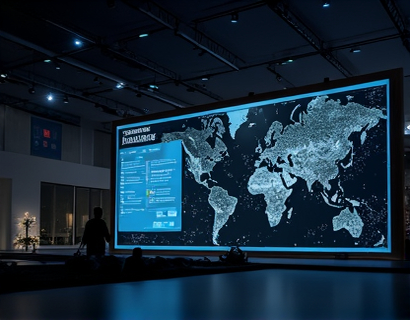Next-Gen QR Code Solutions: Transforming Business Engagement and Social Media Interaction for Modern Enterprises
In the rapidly evolving digital landscape, businesses and social media managers are constantly seeking innovative ways to enhance engagement and interaction with their audience. One such technology that has emerged as a game-changer is the next-generation QR Code, often referred to as enhanced or intelligent QR Codes. These advanced codes go beyond the traditional static barcode, offering customizable and intuitive tools that streamline information sharing and significantly boost customer interaction. This article delves into the transformative potential of next-gen QR Codes, exploring how they are reshaping the way modern enterprises connect with their audience and enhance their digital presence.
The Evolution of QR Codes
QR Codes, or Quick Response Codes, were first developed in the early 1990s in Japan for tracking parts in vehicle manufacturing. Over the years, they have evolved from simple barcodes used for product tracking to versatile digital tools that can store a wide range of data, including URLs, text, contact information, and even multimedia content. However, the limitations of traditional QR Codes, such as fixed size and limited data capacity, have led to the development of next-gen QR Codes, which offer enhanced functionalities and greater flexibility.
Key Features of Next-Gen QR Codes
Next-gen QR Codes are designed with modern needs in mind, incorporating several key features that set them apart from their predecessors:
- Dynamic Content: Unlike static QR Codes that link to a fixed URL, dynamic QR Codes can be updated in real-time. This means that the information linked to a QR Code can change without needing to create a new code, making it highly flexible and efficient for businesses that need to update content frequently.
- Increased Data Capacity: Next-gen QR Codes can store significantly more data than traditional codes. This allows for the inclusion of detailed information such as long text, multiple URLs, and even multimedia content, providing a richer user experience.
- Customizable Designs: Modern QR Codes can be customized with various colors, shapes, and logos, making them more visually appealing and brand-friendly. This customization option helps businesses integrate QR Codes seamlessly into their marketing materials and branding.
- Multi-Language Support: Next-gen QR Codes can encode text in multiple languages, making them ideal for global businesses and international audiences. This feature ensures that information is accessible to a broader audience, enhancing inclusivity and engagement.
- Error Correction: Advanced error correction algorithms ensure that QR Codes remain readable even if they are partially damaged or scanned from a distance. This reliability is crucial for maintaining a positive user experience.
Enhancing Business Engagement
The integration of next-gen QR Codes into business strategies can significantly enhance engagement with customers and stakeholders. Here are some ways businesses can leverage these advanced codes:
Firstly, dynamic QR Codes can be used to create interactive experiences that encourage customer participation. For example, a retail store can place QR Codes on product packaging that link to exclusive content, such as behind-the-scenes videos, customer testimonials, or special offers. This not only provides value to the customer but also increases the likelihood of them engaging with the brand further.
Secondly, next-gen QR Codes can streamline the process of collecting customer data. By scanning a QR Code, customers can easily sign up for newsletters, promotions, or loyalty programs. The dynamic nature of these codes allows businesses to update the linked landing pages with new offers or information, keeping the engagement fresh and relevant.
Additionally, QR Codes can be used to enhance in-store experiences. For instance, a museum can place QR Codes next to exhibits that, when scanned, provide additional historical context, audio guides, or interactive content. This enriches the visitor's experience and can lead to longer visit durations and higher satisfaction rates.
Boosting Social Media Interaction
Social media platforms are a critical channel for businesses to connect with their audience. Next-gen QR Codes can play a pivotal role in boosting interaction on these platforms:
One effective use case is integrating QR Codes into social media posts and ads. For example, a brand can include a QR Code in a Facebook post that, when scanned, directs users to a landing page with a special discount or a video showcasing the product's features. This not only drives traffic to the desired destination but also increases the chances of conversion.
Instagram and other visual platforms can benefit from QR Codes by linking them to augmented reality (AR) experiences. A fashion brand, for instance, can place a QR Code on a billboard or in a magazine that, when scanned, triggers an AR experience showing how an outfit would look on the user. This immersive experience can significantly enhance user engagement and brand recall.
Moreover, next-gen QR Codes can be used to create interactive contests and giveaways on social media. A brand can generate a unique QR Code for each contest entry, making it easy to track participation and reward winners. The dynamic nature of these codes ensures that the contest can be updated or modified on the fly, keeping the engagement fresh and exciting.
Case Studies and Success Stories
Several businesses have already seen the benefits of implementing next-gen QR Code solutions. Here are a few notable examples:
A leading automotive brand used dynamic QR Codes on their dealership websites to provide customers with real-time inventory updates and personalized offers. This not only improved the customer experience but also increased sales by 15% within six months of implementation.
A travel agency integrated QR Codes into their brochures, linking to virtual tours of destinations and special promotions. This innovation led to a 30% increase in bookings, as customers were more engaged and informed about the travel options.
A fashion retailer implemented QR Codes on their in-store displays, which linked to AR try-on experiences. This feature resulted in a 40% increase in customer engagement and a significant boost in sales for the featured items.
Implementing Next-Gen QR Codes
For businesses looking to harness the power of next-gen QR Codes, the implementation process is straightforward and user-friendly:
1. Choose a Reliable Provider: Select a platform that specializes in creating and managing next-gen QR Codes. Look for features such as dynamic content updates, customizable designs, and comprehensive analytics.
2. Define Objectives: Clearly outline the goals for using QR Codes, whether it's to drive website traffic, increase sales, or enhance customer engagement. This will help in designing the QR Code strategy effectively.
3. Create Dynamic Content: Develop the content that will be linked to the QR Codes. This can include URLs, text, images, videos, or even interactive elements like polls or surveys.
4. Design and Deploy: Use the provider's tools to design the QR Codes, customizing them with your brand's colors and logo. Deploy these codes across various touchpoints, such as physical stores, marketing materials, and social media posts.
5. Monitor and Analyze: Utilize the analytics provided by the platform to track the performance of your QR Codes. Monitor metrics such as scan rates, user interactions, and conversion rates to refine your strategy and optimize results.
Future Trends in QR Code Technology
The future of QR Code technology is promising, with several trends poised to further enhance their utility and impact:
Firstly, the integration of QR Codes with 5G technology will enable faster data transfer and more seamless experiences, particularly for AR and VR applications.
Secondly, the rise of IoT (Internet of Things) devices will see QR Codes playing a crucial role in device identification and data retrieval, streamlining processes in various industries.
Lastly, the development of QR Code standards and interoperability will ensure that these codes can be used consistently across different platforms and devices, enhancing their universal applicability.
In conclusion, next-gen QR Codes offer modern enterprises a powerful tool to enhance business engagement and social media interaction. By leveraging the dynamic, customizable, and user-friendly features of these advanced codes, businesses can create more meaningful and engaging experiences for their audience, ultimately driving growth and success in the digital age.










































